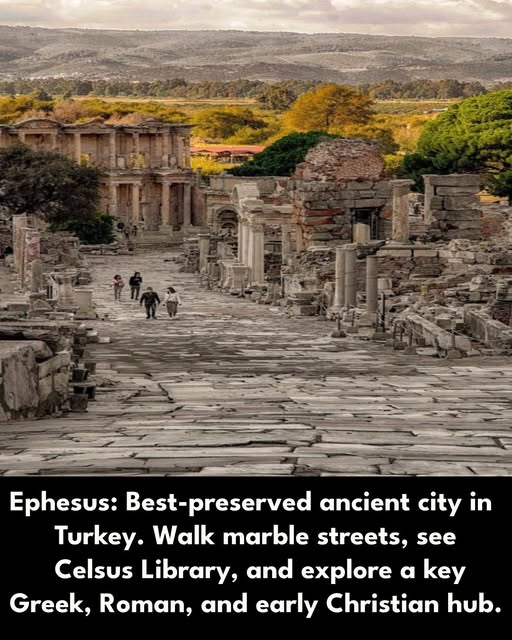
It begins with the sound of footsteps on marble. Not modern rubber soles, but leather sandals, soft and deliberate, brushing against polished white stone under a golden Anatolian sun. The same sound has echoed here for over two thousand years—through conquest, prophecy, celebration, and silence. This is Ephesus, the city that did not vanish, but endured.
Nestled near the coast of western Turkey, where the Cayster River once fed a thriving port, Ephesus is more than a ruin—it is a city paused mid-breath. It is the closest one can come to walking inside a page of ancient history, a place where Greek philosophy debated Roman law, and where the whispers of early Christianity clung to sun-warmed stone.
Today, visitors arrive from every corner of the world, winding down the marble-paved Arcadian Way, past the remains of temples, shops, fountains, and homes. But long ago, the journey to Ephesus was made not by tourists, but by merchants, scholars, priests, and emperors. Each came to bask in the intellectual and commercial glow of one of the most important cities of the ancient Mediterranean world.
Founded in the 10th century BC by Ionian Greeks, Ephesus rose to prominence with the construction of the Temple of Artemis, one of the Seven Wonders of the Ancient World. Larger than the Parthenon and adorned with bronze, ivory, and gold, the temple stood not just as a monument to the goddess, but as a symbol of Ephesus’s wealth, ambition, and influence. It drew pilgrims and poets alike—though today only foundations and scattered columns remain.
But if the temple whispered of divinity, the heart of the city was its library—the Library of Celsus, a breathtaking structure completed in 117 AD by the Romans. Its soaring façade, crowned with Corinthian columns and statues of wisdom, knowledge, and virtue, once housed over 12,000 scrolls. Here, scribes copied Greek texts into Latin and vice versa. Here, scholars gathered under the cool shade of the portico to debate Aristotle, Plato, and the teachings of a new prophet from Galilee.
As the Roman Empire enveloped Ephesus, the city flourished. The streets were lined with mosaics, public baths, fountains fed by aqueducts, lavish villas with intricate frescoes, and even a complex sewage system far ahead of its time. Gladiators fought in the theater, which seated over 25,000 spectators. Across the street, philosophers and lawyers argued cases in the Odeon. It was a place of refinement and spectacle, of reason and ritual.
But it was also a city of change.
In the 1st century AD, Paul the Apostle arrived in Ephesus, preaching in synagogues and marketplaces. His letters to the Ephesians would later form part of the New Testament. The city, once a bastion of paganism, slowly transformed into a hub of early Christianity. In the nearby House of the Virgin Mary, tradition holds that Mary herself spent her final years, cared for by the Apostle John. The Council of Ephesus, one of the earliest ecumenical councils of the Church, convened here in 431 AD, shaping doctrines that would reverberate across centuries.
And yet, Ephesus could not escape the tide of time.
By the 7th century, invasions, earthquakes, and the gradual silting of its harbor forced its decline. The once-great port city found itself landlocked and vulnerable. Slowly, it faded from glory. Its monuments crumbled under vines and silence. Pilgrims no longer came. The theater emptied. The scrolls vanished.
But Ephesus did not die. It slept.
And in the 19th century, it was gently awakened.
Archaeologists unearthed its streets like dreamers lifting a veil. Each discovery was a revelation: a statue, a column, an inscription, a moment from history rising from the soil. Today, Ephesus stands as the best-preserved ancient city in Turkey, perhaps in all of Europe. Its marble bones still glisten under the same sun that once lit the faces of Stoics and Caesars.
To walk through Ephesus is to lose your sense of centuries. You stand where Socratic dialogue mingled with imperial decree. You sit on theater steps that once roared with the cries of gladiators. You lean against sun-warmed stones that once bore the footsteps of saints and soldiers alike.
It is not just a place to visit. It is a place to feel.
Feel the weight of a thousand stories etched into stone.
Feel the hum of human endeavor, echoing across time.
Feel the paradox of permanence—that cities fall, but memory endures.
So when you step into Ephesus, do not just take pH๏τos. Pause. Listen.
You may hear footsteps.
Or perhaps… echoes of your own.
Because Ephesus remembers.